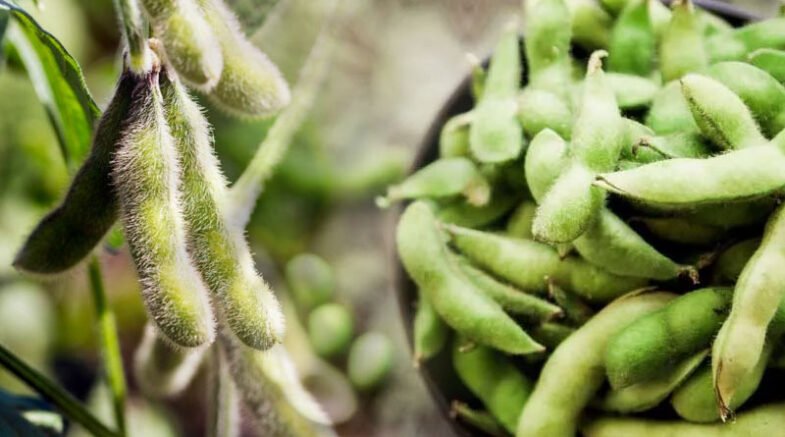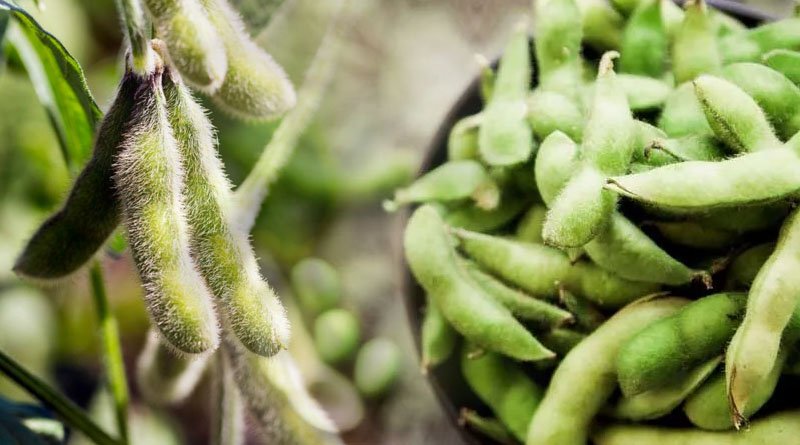Soybean is a self-pollinated crop. The color of self-pollinating flowers are white and shades of purple. Seeds color change. It can be green, yellow, brown, or black.

The botanical name of soybean is Glycine max. Soybean belongs to the Legume family (Fabaceae). Its chromosome number is 2n=2x=40. Soybean is also known as soja bean.
Soybean is a self-pollinated crop. The color of self-pollinating flowers are white and shades of purple. Seeds color change. It can be green, yellow, brown, or black.
Though commercial varieties have brown ten seeds, four seeds are present per pod. The soybean is the most important bean in the world, providing vegetable oil for millions of people and hundreds of chemical products.
Types:
There are different types of soybeans according to seed colors.
Green soybean: It is also called edamame. It is used to make salads, soup and stir-fries.
Yellow soybean: It is used to make tofu, soy milk, tamari. Producers use yellow soybean. They play a important role in soy flour for baking.
Black soybean: Black soybean use in traditional dishes. Soybean is a staple food of Asia .
Composition:
Soybean of legume family rich in protein. It contains nine essential amino acids .It is a source of protein for many people. Soybean having
40% Protein
20% Lipid
17% Cellulose and hemicellulose
7% Sugar
6% Ash
5% Crude fiber
Soybeans are low in saturated fat and high in Vitamin C.They are also contain of Zn,P,S and iron.
Composition of Soybean oil: Soybean oil contains five fatty acids .Stearic acid 4%,Palmatic acid 11%,Oleic acid 23%, Linoleic acid 1%, Linoleic acid 54%.
Fatty acid of Soybean oil:
a). Fatty acid Composition of saturated
It contains of Lauric ,Mystic , Palmitic acid, Stearic and Arachidic acid. Saturated Fatty acid may contain no double bond (easy to break). They have low melting and boiling points. Fats containing saturated fatty acids are solid CH3(CH2)14COOH. Palmitic acid (C16)
b). Fatty acid Composition of unsaturated
It has Oleic acid (C18). They have high melting and boiling point due to the double bond’s presence. Unsaturated fatty acids are liquid at room temperature. CH3(CH2)7CH=CH(CH2)8COOH. Oleic acid (C18)
Fatty acid soluble in organic solvent (Ether, Ethanol, Chloroform) . Their melting point increase with increasing Carbon number in chain .Saturated fats are easily absorb in human body because they are very stable and don’t react with other molecules due to presence of single covalent bond.
Importance and Uses:
Soybean plays an Important role in Human health and in Industries.
a) Beneficial Uses for Human
Soybean is a major source of protein. Unlike other plant proteins, we can obtain all essential amino acids according to our body requirements.
It reduces the Cholesterol level in human body. High level of Cholesterol increase the risk of heart attack. If people eat 1/3 cups of Soybean protein per day, they will reduce the low-density lipoprotein cholesterol 3-4%.
It regulates the blood sugar levels. Some people eat more Sugar on regular basis, having more chance of chronic disease (like diabetes). Soybean doesn’t increase the sugar levels. It decreases the chance of cancer.
Estrogen promote the certain types of cancer such as breast cancer. Sex hormone of estrogen is a Isoflavones, which is a present in high amount in soybean. Soybean contain high amount of Isoflavones.it might minimum bone loss. Isoflavones may protect this situation in middle aged or old women.
b) Source of animal feed
Byproduct (raw materials and Soybean meal) of soybean also used for animal feed. It is a major source of protein for domestic animals like Chicken, pig, fish feed, cattle and many meals. Soybean meal contributes about 30% to polutry feed. SBM fulfill the feed requirements of animal for amino acid due to the cost effective source of amino acid.
c) Industrial uses
Soybean of legume family also plays an important role in nonfood application. It is use to make rubbers, fibers, plastics, coating, lubricants and in consumer products as a ingredient.
This article is jointly authored by Amina, Dr. Humera Razzaq, Dr. Farooq Ahmed Khan and Sana-e-Mustafa from Department of Plant Breeding and Genetics, University Agriculture of Faisalabad.
